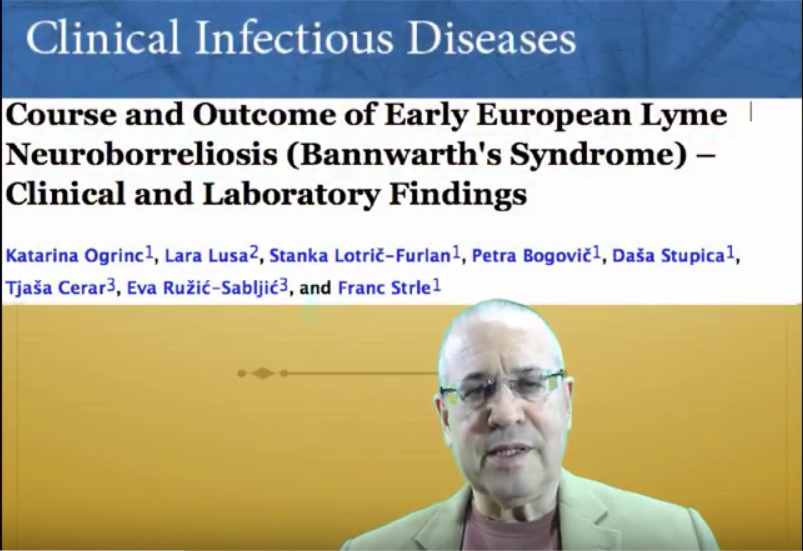Video Blog: More problems with 2-week course of antibiotics for Lyme disease

There are physicians who continue to advise patients that 2 weeks of antibiotics is sufficient for treating Lyme disease (LD). [1,2] Their position has not changed despite the growing recognition that Lyme disease complications can occur after 2 weeks of antibiotic treatment. These difficulties include chronic neurologic LD, [3] Lyme encephalopathy, [4,5] Post Lyme disease, [6] and Post-Treatment Lyme Disease Syndrome (PTLDS). [7]
by Daniel J. Cameron, MD MPH
As early as 1990, Logigian and colleagues hypothesized that a two-week course of intravenous ceftriaxone would not successfully eradicate the Lyme bacterium. “The likely reason for relapse is failure to eradicate the spirochete completely with a two-week course of intravenous ceftriaxone therapy.” [3]
A recently published clinical trial from Slovenia offers insight into the problems with prescribing a two-week course of antibiotics. Researchers described the outcome of treating 77 patients with early European Lyme neuroborreliosis, sometimes referred to as Bannwarth’s Syndrome. [8]
The most frequent symptoms/signs were radicular pain, sleep disturbances, erythema migrans, headache, fatigue, malaise, paresthesias, and peripheral facial palsy. Meningeal signs and pareses were present in 19.5% and 7.8% respectively. One patient with radicular pain had a complete heart block and a lymphocytic pleocytosis by spinal fluid examination. [8]
Only 2 of their 77 patients were treated with more than two weeks of antibiotics:
- 72 patients were treated with ceftriaxone for two weeks;
- 2 patients were treated with ceftriaxone for three weeks;
- 2 patients were treated with doxycycline because of allergy to ceftriaxone;
- 1 patient was treated with doxycycline because of refusal of parenteral therapy.
Authors of the Slovenia trial identified several problems with the 2-week course of antibiotics.
1.) Antibiotics often had to be repeated. “Antibiotic therapy was repeated within 3 to 6 months in 20/77 (26%) patients because of unsatisfactory clinical response to the first treatment (3 patients), persistence of CSF cell count >10×106cells/L (8 patients), or both (9 patients),” according to Ogrinc. [8]
2.) Treatment failures were identified at the end of 6- or 12-month follow-up, despite retreatment. “Unfavorable long-term clinical outcome was observed in 9/74 patients (12%) and consisted of intense/annoying nonspecific symptoms, persistent PFP, or remaining pareses that influenced functioning,” Ogrinc points out. [8]
Unfavorable long-term clinical outcomes were defined as “partial improvement: partial regression of symptoms/signs, which still require substantial quantities of analgesics and/or significantly influence daily activities” or as “failure: persistence, intensification, or appearance of new symptoms/signs, and/or positive post-treatment CSF, skin, or blood cultures for Borrelia.” [8]
3.) Poor outcomes after 2 weeks of antibiotics occurred despite the relatively short duration of illness. The median duration of illness was 30 days for early European Lyme neuroborreliosis. Twelve of the 77 patients (15.6%) were ill for less than 2 months. [8]
Poor outcomes were also recently reported in a Netherlands’ study. [9] The 98 patients with persistent Lyme disease symptoms demonstrated only a slight improvement in their quality of life following a 2-week course of intravenous ceftriaxone. The physical-component summary score, which measures their quality of life, rose by only 3 points to 34.8. Their quality of life remained below that of cancer and heart attack patients.
Such findings are not limited to the European continent. A study in the U.S. found that despite a 3-week course of antibiotics, more than one-third of patients who presented with a erythema migrans rash were ill at 6-month follow-up.
“At 6 months, 36% of [66] patients reported new-onset fatigue, 20% widespread pain, and 45% neurocognitive difficulties,” according to Aucott, Johns Hopkins University School of Medicine. [7]
None of the patients described by Aucott were retreated as described in the Slovenia study. Instead, Aucott and colleagues concluded that their patients suffered from a Post-Treatment Lyme Disease Syndrome (PTLDS). Aucott noted, “Patients who developed PTLDS had significantly lower life functioning compared to those without PTLDS.” [7]
As doctors, we must develop better treatment regimens than the two- to three-week courses of antibiotics described in the Slovenian, Netherlands, and Aucott trials in order to avoid treatment failure. [7-9]
Dr. Daniel Cameron discusses in an All Things Lyme video blog the shortcomings of a recent study suggesting that 2 weeks of antibiotic therapy is effective in treating Lyme disease.
References:
- Sanchez E, Vannier E, Wormser GP, Hu LT. Diagnosis, Treatment, and Prevention of Lyme Disease, Human Granulocytic Anaplasmosis, and Babesiosis: A Review. Jama, 315(16), 1767-1777 (2016).
- Wormser GP, Dattwyler RJ, Shapiro ED et al. The clinical assessment, treatment, and prevention of lyme disease, human granulocytic anaplasmosis, and babesiosis: clinical practice guidelines by the Infectious Diseases Society of America. Clin Infect Dis, 43(9), 1089-1134 (2006).
- Logigian EL, Kaplan RF, Steere AC. Chronic neurologic manifestations of Lyme disease. N Engl J Med, 323(21), 1438-1444 (1990).
- Logigian EL, Kaplan RF, Steere AC. Successful treatment of Lyme encephalopathy with intravenous ceftriaxone. J Infect Dis, 180(2), 377-383 (1999).
- Fallon BA, Keilp JG, Corbera KM et al. A randomized, placebo-controlled trial of repeated IV antibiotic therapy for Lyme encephalopathy. Neurology, 70(13), 992-1003 (2008).
- Krupp LB, Hyman LG, Grimson R et al. Study and treatment of post Lyme disease (STOP-LD): a randomized double masked clinical trial. Neurology, 60(12), 1923-1930 (2003).
- Aucott JN, Rebman AW, Crowder LA, Kortte KB. Post-treatment Lyme disease syndrome symptomatology and the impact on life functioning: is there something here? Qual Life Res, 22(1), 75-84 (2013).
- Ogrinc K, Lusa L, Lotric-Furlan S et al. Course and Outcome of Early European Lyme Neuroborreliosis (Bannwarth’s Syndrome) – Clinical and Laboratory Findings. Clin Infect Dis, (2016).
- Berende A, ter Hofstede HJ, Vos FJ et al. Randomized Trial of Longer-Term Therapy for Symptoms Attributed to Lyme Disease. N Engl J Med, 374(13), 1209-1220 (2016).




Join the Lyme Conversation
(Note: comments are moderated. You will see your comment after it has been reviewed.)